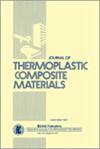含有纤维素纳米晶体/二氧化钛纳米颗粒的可生物降解淀粉基薄膜作为食品包装替代品的开发和评价
IF 3.6
4区 材料科学
Q2 MATERIALS SCIENCE, COMPOSITES
引用次数: 0
摘要
可生物降解的淀粉基薄膜是一种环保的解决方案,可以减少石油衍生聚合物的使用。因此,本研究旨在通过以1:1的比例加入5% w/w的纤维素纳米晶体(CNC)、不同浓度的二氧化钛纳米颗粒(tio2)(0、0.25、0.5、1和2% w/w)和40% w/w的甘油和山梨醇(增塑剂)来获得玉米淀粉薄膜。与未掺入tio2的薄膜相比,仅掺入2wt % tio2的薄膜具有较高的阻挡紫外线的潜力,提高了307%。二氧化钛的使用增加了样品的白色着色能力,并降低了较低的水溶性——与CNC控制样品相比,使用0.5 wt%的二氧化钛可减少约28%。tio2纳米颗粒的掺入提高了薄膜的抗拉强度,加入1wt %的tio2纳米颗粒,而不掺入tio2的薄膜的抗拉强度提高了34%。当tio2含量为1 wt%, CNC含量为5 wt%时,膜的热稳定性提高了85℃。因此,CNC和tio2的加入改善了薄膜的物理/热/化学性能,使其成为食品包装的可能替代品。本文章由计算机程序翻译,如有差异,请以英文原文为准。
Development and evaluation of biodegradable starch-based films containing cellulose nanocrystals/titanium dioxide nanoparticles as an alternative for food packaging
Biodegradable starch-based films are an environmentally friendly solution to reduce the use of petroleum-derived polymers. Thus, this work aims to obtain corn starch films by incorporating 5% w/w of cellulose nanocrystals (CNC), different concentrations of titanium dioxide nanoparticles (TiO 2 ) (0, 0.25, 0.5, 1, and 2% w/w), and 40% w/w of glycerol and sorbitol (plasticizers), in a 1:1 ratio. The films showed a high potential for UV-light barrier, with an increase of 307% incorporating only 2 wt% of TiO 2 in relation to the film without incorporation of TiO 2 . The use of TiO 2 increased the white pigmentation capacity of the samples and decreased the lower water solubility – a reduction of approximately 28% using 0.5 wt% TiO 2 compared to the CNC control sample was observed. The incorporation of TiO 2 nanoparticles increased the tensile strength by adding 1 wt% of TiO 2 nanoparticles with 34% increase in the tensile strength of the film without incorporation of TiO 2 . The thermal stability of the films with 1 wt% TiO 2 and 5 wt% CNC increased by 85°C. Thus, the addition of CNC and TiO 2 enabled an improvement in the physical/thermal/chemical properties of the films, making them possible alternatives for use in food packaging.
求助全文
通过发布文献求助,成功后即可免费获取论文全文。
去求助
来源期刊

Journal of Thermoplastic Composite Materials
工程技术-材料科学:复合
CiteScore
8.00
自引率
18.20%
发文量
104
审稿时长
5.9 months
期刊介绍:
The Journal of Thermoplastic Composite Materials is a fully peer-reviewed international journal that publishes original research and review articles on polymers, nanocomposites, and particulate-, discontinuous-, and continuous-fiber-reinforced materials in the areas of processing, materials science, mechanics, durability, design, non destructive evaluation and manufacturing science. This journal is a member of the Committee on Publication Ethics (COPE).
 求助内容:
求助内容: 应助结果提醒方式:
应助结果提醒方式:


